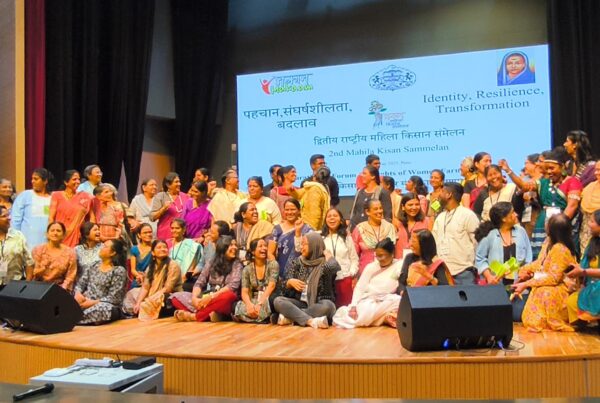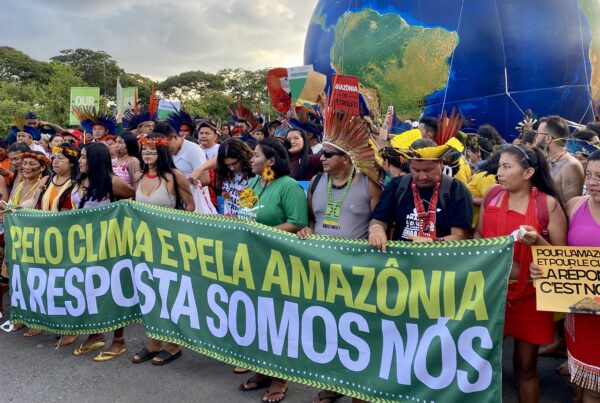By Brian Williams and Jayson Maurice Porter.
In the U.S. South, cotton plantations served as an early laboratory for the toxic development and mass application of agrochemicals. Anti-Blackness shaped the formulation of this harmful agrarian calculus, and cotton, white supremacy and other poisons served as an important antecedent to the subsequent development of chemical-intensive industrial agriculture.
In August 1922, the United States Department of Agriculture repurposed two military biplanes to spread tons of calcium arsenate over the fields of Shirley and Hermione Plantations in Tallulah, Louisiana. This practice soon became common throughout the plantation South. After the abolition of slavery, southern cotton planters, no longer able to count on the comparative advantage of enslaved labor, looked to technologies to maintain a profitable position during the global expansion of cotton.
Few technologies were more critical than arsenical insecticides and airplanes. With raw white arsenic mined in Canada, Mexico, and the American West, and military planes returning from war in Europe, U.S. cotton planters set the stage for a new battle to protect cotton at home. This toxic arsenal took off quickly, inspiring and integrating violent military logic into industrial agriculture to better control cotton pests, plantations, and surrounding communities. Starting in this interwar period (1919-1939), U.S. businessmen, scientists, and government officials cooperated in novel ways to reroute technologies and materials created for selective destruction of living things.
As we argue in our Environmental Humanities article that places this moment in a longer history of cotton plantation development, anti-Blackness played a substantial role in the formation of the global agrochemical complex. Seemingly technical calculations of pesticides’ profitability embodied anti-Black racism in their violent displacement of cotton’s crises onto poor farmers and plantation lands, which further marginalized the Black workers who farmed those lands. Such calculations reflected and reinforced the conditions that made them possible: Black farmers without land, living and working in fields they did not own with chemicals that poisoned them.
These political ecologies of cotton continued to shape the devaluation and erosion of Black life and land into the 20th century, decades after the abolition of slavery. The rapid spread of chemicals coincided with to the great forced migration of Black landowners and workers from the south. Porter’s grandmother Delores Scott, for instance, remembers seeing planes dropping chemicals across Maryland’s Eastern Shore in the 1940s when she visited the land her family left for Philadelphia a decade earlier. Because racism enabled the dismissal of their harmful effects on lands and people, arsenic insecticides represented a profitable means of disposing of toxic wastes into cotton plantations (Romero 2021). This served as an industrial-scale unit and laboratory for violent experimentation.

A cloud of calcium arsenate dispersed by aircraft over fields in the Mississippi Delta. From Coad, B. R., Elmer Johnson, and Guy L. McNeil, Dusting Cotton from Airplanes (U.S. Department of Agriculture, 1924), p. 18.
The monocultural expanse of cotton plantations in the South represented a confluence of interconnected and racialized toxicities: white cotton, white arsenic, and white supremacy. Early reports by white researchers and “cropduster” pilots ignored the people who lived and worked in these fields—whose health and lives were most directly at stake. Research on the profitability of “cotton poisons” was instead filtered through a reductive calculus of plantation racism when workers were acknowledged. Instead of exhibiting concern about the effects of chemicals on people, researchers and planters alike were most concerned with the potential of these chemicals to protect cotton, and how best to disperse them broadly and efficiently over plantation lands. For instance, researchers described workers’ homes, scattered throughout the fields, only as “obstacles” to poison-bearing planes.
Although arsenical insecticides were first introduced after the abolition of slavery, the anti-Blackness that shaped their use and distribution was central to the early development of fertilizers for plantations before the Civil War. Few people embodied the anti-Blackness undergirding conceptions of fertilizers more than Edmund Ruffin. Before the Civil War, Edmund Ruffin was frequently heralded as the founder of U.S. soil science and an infamous pro-slavery secessionist. Ruffin’s dual investments in slavery and soil informed his highly influential work on fertilizers titled Essay on Calcareous Manures (1832). This essay provides insight into how white supremacy and anti-Blackness informed the very presuppositions of the early chemicalization of agriculture. Ruffin explicitly argued that fertilizers could help sustain the plantation system and the institution of slavery while combatting soil erosion.
Ruffin also promoted the extraction of marl (sedimentary rock containing limestone) to augment soils depleted by plantation agriculture. For him, marling operations were economically beneficial because the tedious labor of extraction could be undertaken by enslaved persons in time not otherwise devoted to other tasks. In his calculations, any time not consumed by plantation work on the part of the people he enslaved was time wasted. Such calculations, oriented toward the maintenance of plantation slavery, treated the people he enslaved as interchangeable units of energy and potential work that could effectively be converted into nutrients through the extraction of geological materials.
In the estimation of Ruffin and other enslavers preoccupied with the science of agricultural productivity, the devaluation of Black life forms the basis of calculation (see Yusoff 2018). This violent and fundamental racism, expressed in everyday scientific and economic language, is echoed throughout the subsequent development of plantation chemistry both before and after abolition. This included later calculations of the profitability of pesticides.
The exhaustion of supplies of guano-based fertilizers in the early 1870s also accelerated planters’ speculations in chemicals. Since the 1840s, these nutrient-rich deposits of seabird feces, mined off the coasts of Peru by indentured Peruvian and Chinese laborers, aided the intensification of cotton production in the United States. Without guano and slavery, planters and industrialists from Charleston to Baltimore turned to manufacturing new fertilizers, particularly phosphate mined on former plantation lands. These phosphate mines, concentrated in South Carolina and Florida, were sustained by imprisoned Black workers forced to labor for free.
Southern cotton fields were the primary destination of these chemicals. Even though Black southerners and their allies mobilized for land redistribution, justice, and full citizenship after abolition, former enslavers and their partners deployed violence, foreclosed justice, and preserved the plantation system. White landowners endorsed sharecropping, an arrangement in which farmers worked the land for only a share of the crop. In the sharecropping and tenant farming system, plantation owners and creditors often demanded that landless farmers use fertilizers as a precondition for financial support.
The cost of fertilizers, advanced on credit, would then be subtracted from any profits from the crop—with interest. Sharecropping therefore solidified arrangements of debt, underpinned by anti-Black racism and white monopolization of land. This agrochemical shift displaced more sustainable, diverse, and equitable ways of farming.

Figure 2. Cropduster spreading pesticides over a field in the Mississippi Delta, June 2022. Photograph by Brian Williams.
Arsenic-based insecticides such as Paris Green, lead arsenate, and calcium arsenate increasingly supplanted enslaved Black workers’ highly laborious techniques to protect cotton monocultures from insect predation before abolition. With insecticides, anti-Black racism was central to preserving an ecologically-destructive monoculture at a massive scale. One toxin reinforced another; racism provided the conduit and the canvas for arsenic to spread.
As Liboiron, Tironi, and Calvillo argue, toxicity is determined by relationships and regimes of power that shape and constrain life and relations: toxicity isn’t an inherent property of chemical compounds (see also Liboiron 2021). Planters, researchers, and financiers, who treated Black life as expendable and appropriable, determined and facilitated insecticides’ toxic travels and effects. This agrarian racism, a precondition for the continued dominance of cotton, enabled the rapid proliferation of chemicals in the early decades of the twentieth century.
Agrochemicals altered the nature and toxicity of anti-Blackness in cotton production. Synthetic fertilizers and arsenical insecticides changed the speed, scale, and ecology of plantations while extending the material pathways of racism. These chemicals did not introduce toxicity to white supremacy’s toolkit of extraction, but instead helped make environmental racism both diffuse and durable in a modernizing and globalizing world. Chemical-intensive agriculture relied on settler logics of replacement; it replaced Indigenous communities and practices; it replaced exhausted land with chemicals; it replaced exhausted Black laborers with more Black laborers; eventually replacing Black laborers altogether.
As the nature of growing cotton through many toxicities increased in speed and scale, and mechanical cotton pickers were deployed to harvest the fruit of these toxicities, landscapes of control were consolidated. This process so often served to marginalize and poison the people closest to the land, while generating replicable techniques for expanding toxic geographies.
—
Brian Williams is an assistant professor of human geography in the Department of Geosciences at Mississippi State University. His research combines political ecology and Black geographies to trace the cultural and ecological impacts of racism and plantation agriculture on southern landscapes, while highlighting Black southerners’ work to envision and cultivate sustainable and just alternatives.
Jayson Maurice Porter is a Voss Postdoctoral Research Associate of Environment and Society at Brown University’s IBES, where he investigates food and agricultural systems, agrochemicals, oilseeds, and environmental violence and justice in the Americas. He specializes in the history and political ecology of oilseed-based extraction and resistance in Black, Indigenous, and Agrarista regions of Guerrero, Mexico.
—
Bibliography
Coad, B. R., et al. Dusting Cotton from Airplanes. U.S. Department of Agriculture, 1924.
Liboiron, Max. Pollution Is Colonialism. Duke University Press Books, 2021.
—. “Toxic Politics: Acting in a Permanently Polluted World.” Social Studies of Science, vol. 48, no. 3, June 2018, pp. 331–49. SAGE Journals, https://doi.org/10.1177/0306312718783087.
Mancini, Francesca, et al. “Acute Pesticide Poisoning among Female and Male Cotton Growers in India.” International Journal of Occupational and Environmental Health, vol. 11, no. 3, 2005, pp. 221–32.
McKinley, Shepherd W. Stinking Stones and Rocks of Gold: Phosphate, Fertilizer, and Industrialization in Postbellum South Carolina. University Press of Florida, 2014.
Romero, Adam M. Economic Poisoning: Industrial Waste and the Chemicalization of American Agriculture. Univ of California Press, 2021.
Ruffin, Edmund. An Essay on Calcareous Manures. 2d ed., J.W. Campbell, 1832, http://hdl.handle.net/2027/loc.ark:/13960/t2d79t89r.
Williams, Brian, and Jayson Maurice Porter. “Cotton, Whiteness, and Other Poisons.” Environmental Humanities, vol. 14, no. 3, Nov. 2022.
Yusoff, Kathryn. A Billion Black Anthropocenes Or None. University of Minnesota Press, 2018.





